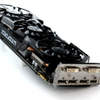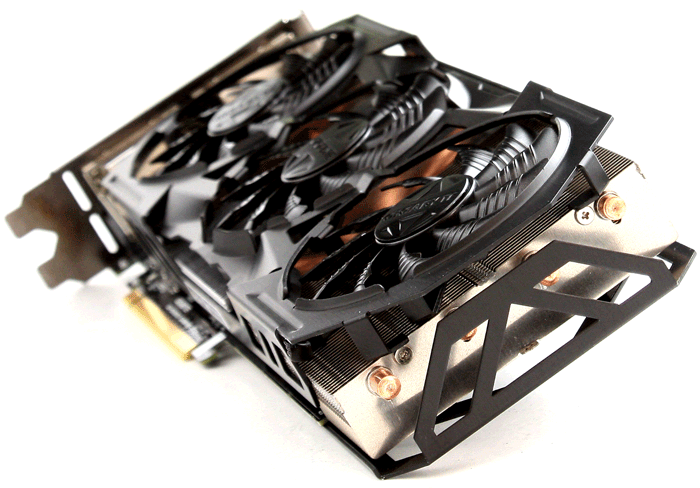Conclusion
Conclusion
We absolutely like the G1 Gaming series from Gigabyte, the cards look great, perform nice thanks to the factory overclock and cooling with the WindForce coolers simply is sound. Where the reference cards operate at 70 to 80 degrees C you'll notice that this puppy shaves off up-to 25 degrees C on average under full load gaming conditions, roughly 56 degrees C is what we measured whilst being whisper silent. The product comes factory tweaked at a boost frequency of over 1300 MHz which is impressive all by itself really. The card also has a raised power limiter, and as such we noticed it boosting on the dynamic clock frequency over 1400 MHz. We really like the 4 GB models, even if the effect it'll have at 1080P (game resolution of choice for this card) of course remains a little trivial. Fact remains that these products perform nicely for the gamers in the 1920x1080P resolution, even at WQHD at 2560x1440, we have not been disappointed. And that resolution is where 4GB models come in rather handy.
Maxwell GM206 GPU Overall Experience
The GeForce GTX 960 is a pretty complicated piece of technology in terms of what Nvidia offers to its partners and what they made out of it. I am afraid though that Nvidia took it a step too far trying to make the product as cheap as possible. Many of you will not get by the fact that the 128-bit memory bus combined with 2 GB of graphics memory will cripple anything after 1080P. The 4GB models however might be the savior here. Speaking in general, I think people could have lived with the 128-bit bus if the product would have had 3 GB of graphics memory or the other way around. We do feel these products are capable. Performance wise the product will sit in-between a GeForce GTX 760 and a Radeon R9 280 / 7970, and that is still a respectable number.
Thermals
The reference products are set at an offset threshold of 80 degrees C, with a product of this cooling caliber, the numbers will be much lower. Gigabyte makes use of the WindForce 3X cooler offering 300 Watt cooling performance, it is one of the best dual-slot dual fan coolers to date. Expect the temperature to hover around the 55~60 Degrees C threshold with the games that are harder on the GPU. Remember, that is factory overclocked cooling performance for you. Thanks to the fairly low temps, the boost limiters do not kick in as fast and yeah, as stated, do not be surprised to see this card rendering your games at a boost frequency of 1400 MHz.
Cooling VS. Noise Levels
Cooling wise we can’t complain, noise wise it is a good product. You can hear only a tiny bit of airflow, that's it. So expect sound pressure values in the 38 dBA range at best under load and warm circumstances. That's measured 75 cm away from the PC, thus a normal distance in-between you and your PC. That level is to be considered silent.
Performance
The performance of the GeForce 960 series overall is certainly okay if you stick to 1080P, this is really a 1080P card. At 2560x1440 the case becomes trickier with 2 GB, once the card runs out of memory frames will start swapping back and forth in the frame-buffer, resulting in a performance loss. Admittedly, even there the card manages to do OK thanks to compression techniques that save memory, but it definitely is the resolution where you want more than 2GB memory, and thus the 4GB model is applicable here. So overall it will be a fun and sweet Full HD gaming product and yeah, though the specs are a little less exciting, really we are not disappointed by the performance if 1920x1080 is your gaming domain.
Tweaking
Without extra voltage tweaking you can expect a 1450~1500 MHz range for the boost clock frequency. Depending on how much your board will take and allow, with voltage tweaking you’ll reach the 1550 MHz range on the dynamic boost frequency quite easily. We reached a totally stable 1584 MHz as maximum. Variables like your PC stability, power supply and so on are important to any overclock, keep that in mind. The memory is clocked standard at 7.0 GHz, you'll fairly easily achieve 7.5 GHz up towards 8 GHz, you should probably settle at 7.8 GHz for the best stability. Since this card is so limited with its 128-bit memory bus, tweaking that memory will help as it increases memory bandwidth and thus performance as it gives the GPU a little more space to breathe in.
2GB or 4GB
The question whether or not you should go for a 4GB model remains a tricky one to answer. I guess that if you have the budget for it, then go for it -- but we expect a 40 EURO price difference in-between the 2GB and 4 GB models, which is steep. There will be a handful of games where small stutters will become less apparent. Also with future gaming titles obviously you are a little more future proof. Overall, especially at 1080P it will be hard to tell the difference, but sure ... there remains to be a difference. The extra 2GB of memory certainly did not hinder the overclock experience and overall it simply makes the card complete. I find 2GB of graphics memory on the low side, but Nvidia's compression technology proves that it works and that is what is making this very question so difficult to answer. The GTX 960 should probably have been launched with 3 GB VRAM standard, hence I can recommend these 4 GB versions very much. But yeah, the end-results remain a bit trivial with the price-premium in mind -- that I need to admit.
Final Words
The G1 Gaming edition of the GeForce GTX 960 is one of the more rare products that have all the variables right. I simply do not have anything negative to state about the product. All boxes are ticked and that makes this an extremely competitive product. The extra VRAM up-to 4GB (fully usable yes!) we feel will make the product a little more future proof. We find 2GB is shy yet sufficient, 4GB offer you a little breathing space, but do not expect miracles in performance. It is more that with selected games you'll notice a bit less stuttering as some textures already have loaded in graphics memory opposed to loading them mid-game. Other than that the conclusion remains the same as the 2GB model -- the G1 Gaming is one of the faster factory models available. It leads in performance due to the fact that it has the best temperatures as well, that combined with a slightly tweaked power limiter it brings the better performance to this product out of all the cards we tested to date. From top to bottom, in terms of factory overclocked cards versus the several brands, the difference in FPS can be up-to 4 frames on average with a modern game and decent image quality settings. So what I am saying is that the ultra fast clocked version won't be heaps faster, do remember that when you open up your wallet. Purchasing this product to game at WQHD / 2560x1440 is not advised though, 1080P is the space and domain of the GeForce GTX 960. But at 1080P you can use pretty decent image quality settings. Overall the product is getting our top pick award as product within its category, and not because I find the GTX 960 so great. Contrary, it is an OK performing product with the reality that Nvidia is asking too much for it money wise. But within the GTX 960 range, this is one of the best products you can find in the stores hence out Top pick award.
Recommended Downloads
- Sign up to receive a notice when we publish a new article
- Or go back to Guru3D's front page



